- Home
- stock market
- Young people are living in an unemployment crisis in these 47 countries
Young people are living in an unemployment crisis in these 47 countries
47. Libya

46. Sudan
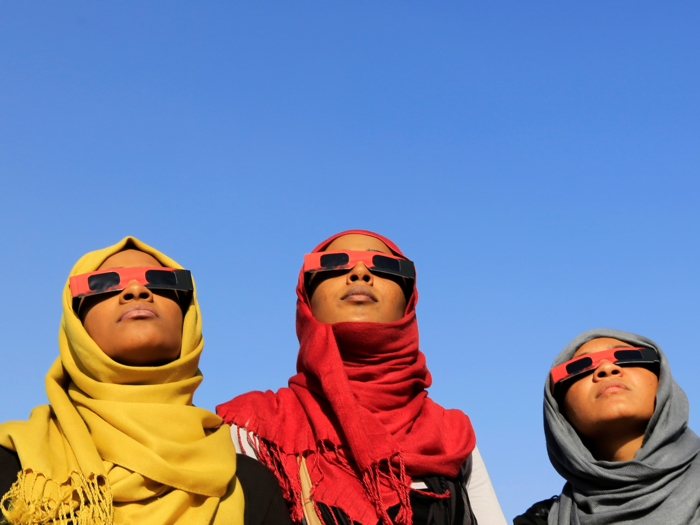
2014 youth unemployment rate (est.): 24.9%
Percentage of population aged 15-24 | under 24: 20.5% | 60.65%.
A 2012 report by the AfDB said that an estimated 62% of students in higher education were studying humanities, while only 32% the sciences. But employment opportunities for youth are in agriculture (42%), public services (19%), and trade (19%). Employers are starting to hire foreign workers to fill the gaps.
Additionally, South Sudan's 2011 independence from Sudan was economically sticky as 75% of oil reserves are in the former, while the refineries and major pipeline remain in the latter.
Source: ILO, CIA World Factbook
45. France
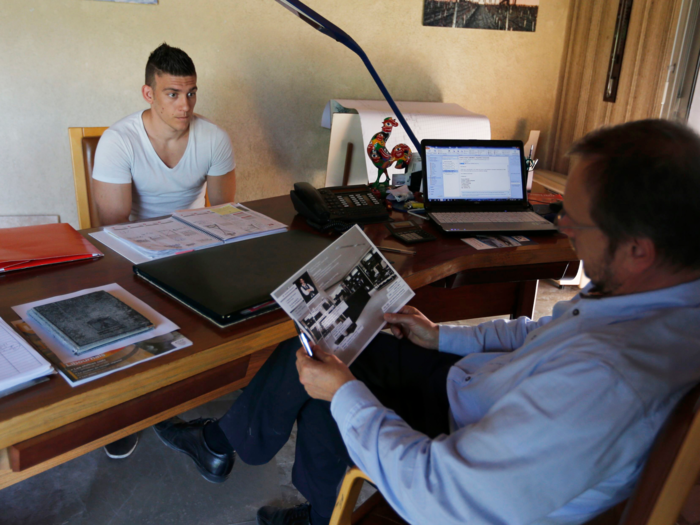
2014 youth unemployment rate (est.): 25.3%
Percentage of population aged 15-24 | under 24: 11.82% | 30.48%
"After six quarters of continuous decline in youth unemployment, the situation of French youth deteriorated in 2014 leaving 24.7% of the youth labor force unemployed in the first quarter of 2015," according to a 2015 report by the OECD.
Moreover, France was only one of three countries in Europe that saw the proportion of youth with temporary jobs rise. "To a certain degree, temporary employment among youth can be viewed as an increasingly standard phenomenon in the career path," notes a report by the ILO.
Source: ILO, CIA World Factbook
44. Slovenia
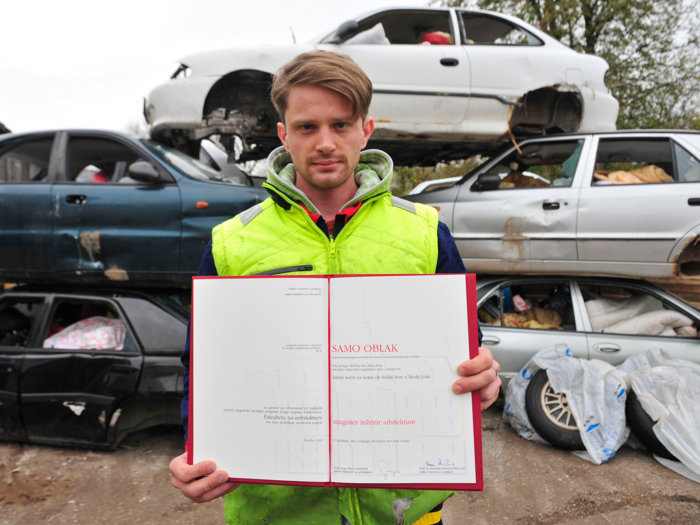
2014 youth unemployment rate (est.): 25.7%
Percentage of population aged 15-24 | under 24: 9.76% | 23.14%
The economic problems of 2007 to 2012 put recent grads at a disadvantage. Plus, young people are more likely to take temp jobs, making them more likely to be fired in hard times.
"According to the methodological approach of self-perceived unemployment, 36.1% of young people were unemployed [in 2013], compared to only 21.1% reported by Eurostat," notes a First CEPYUS-FES Youth Survey. "This large difference can be explained [by the fact that] young people actually perform some kind of occasional work, but do not consider it a real job and therefore consider themselves unemployed."
Source: ILO, CIA World Factbook
43. Hungary
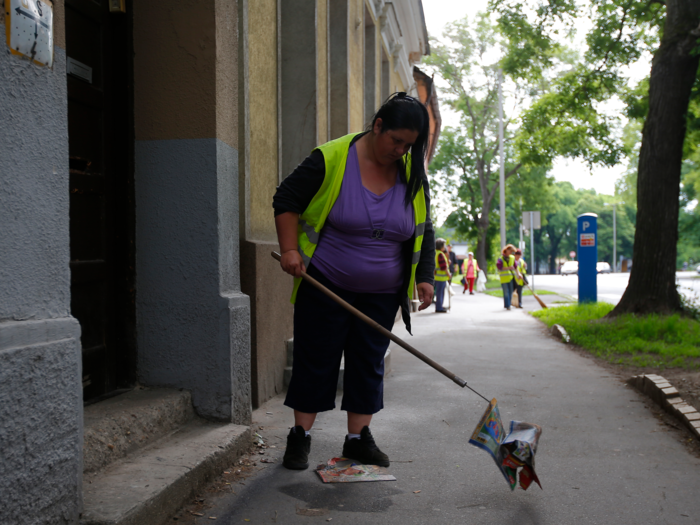
2014 youth unemployment rate (est.): 26.1%
Percentage of population aged 15-24 | under 24: 11.44% | 26.24%
Although right up there with the worst of them in 2012, Hungary saw the greatest drop in youth unemployment in the last two years, with the number falling below the EU average. Over the course of 2014, youth unemployment fell by 5%, which was the third-largest drop in EU member states, according to the Ministry for National Economy.
As of 2015, the youth unemployment rate is at 19.2%. The Hungarian government attributes this reversal to the expansion of the private sector.
Source: ILO, CIA World Factbook
36. to 42.
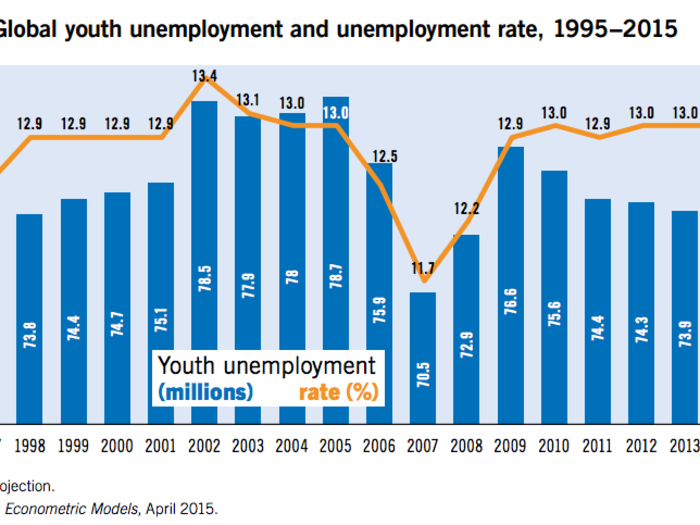
The chart above "reflects the cyclical nature of youth unemployment and reminds us of the often repeated tenet that youth are among the most severely impacted by economic crises," says the ILO.
Data from previous economic crises suggests that it takes about four to five years from the resumption of economic growth to get back to precrisis levels. But it takes longer for youth employment to bounce back.
Case in point: It's almost 10 years since 2007, and the global youth unemployment rate remains above the precrisis rate.
42. Puerto Rico: 27.1%
41. Ireland: 27.7%
40. Barbados: 28%
39. Maldives: 28.1%
38. Bahamas: 28.1%
37. Poland: 28.4%
36. Bahrain: 28.6%
35. Yemen
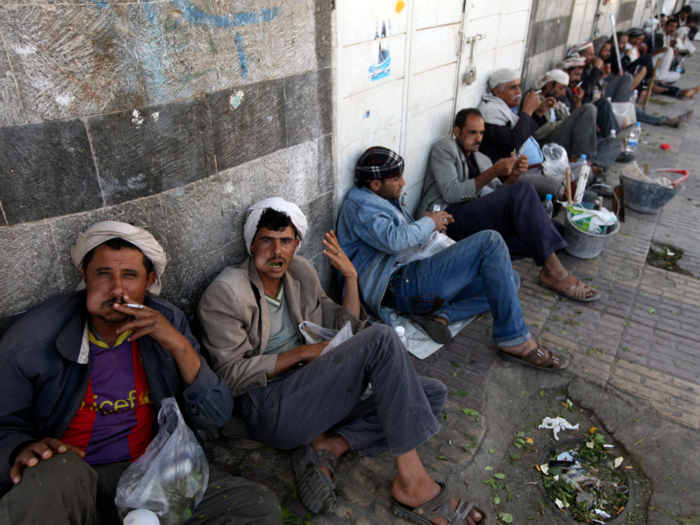
2014 youth unemployment rate (est.): 28.9%
Percentage of population aged 15-24 | under 24: 21.12% | 62.21%
Nearly half of Yemen's population lived below the poverty line, and about 50% of children suffered from malnutrition in 2013. Now, Yemen is in the middle of a civil war. Unemployment was one of the reasons for the recent instability, according to the BBC.
Notably, in 2012 a UN report suggested that youth unemployment "may be a source of instability and breakdown of the democratic process in the region if ... new governments fail to find adequate solutions."
Source: ILO, CIA World Factbook
34. Bulgaria
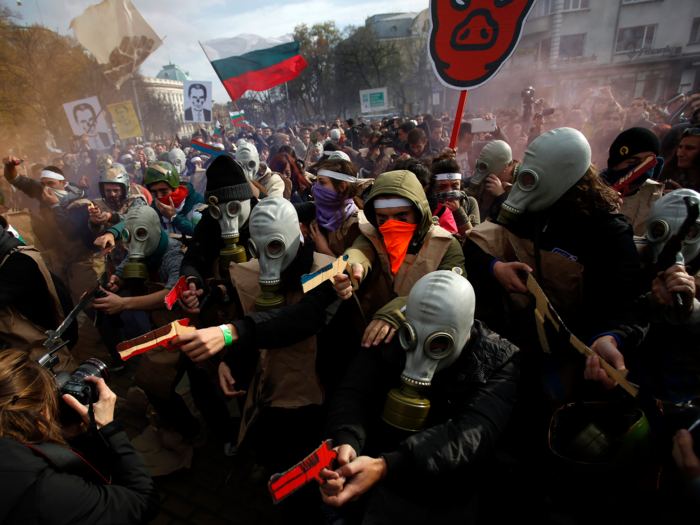
2014 youth unemployment rate (est.): 29.7%
Percentage of population aged 15-24 | under 24: 9.95% | 24.48%
Bulgaria has slowly and painfully been transitioning to a market economy since the end of Communist rule. Although overall unemployment has been falling and inflation has been tamed, incomes and living standards are still low, according to the BBC.
A 2012 report by Friedrich Ebert Stiftung found that Bulgarian education was lower quality, and youths who left school early were further disadvantaged. Furthermore, social status "amplifies the risk of being unemployed."
Youth unemployment rate was reportedly down significantly to 21.6% by December 2014, according to data from Eurostat.
Source: ILO, CIA World Factbook
33. Saudi Arabia
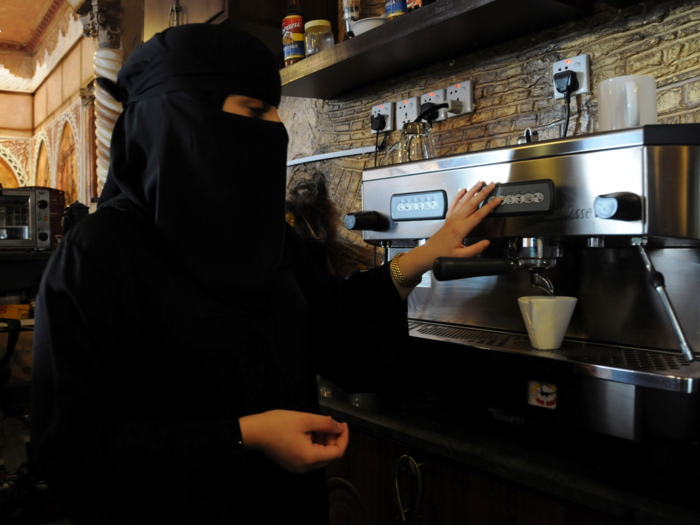
2014 youth unemployment rate (est.): 30%
Percentage of population aged 15-24 | under 24:? 19.11% | 46.18%
Saudi Arabia relies heavily on a large foreign population (with a large chunk coming from India). Moreover, Saudi nationals tend to work in the public sector and have little incentive to join the private sector or to improve productivity, according to HSBC economist Razan Nasser.
But Saudi Arabia's youth population is large, so it could run into the need for job creation as these people get older. And although there has been some improvement in female economic participation, rates are still far below world averages.
Source: ILO, CIA World Factbook?, Business Insider
32. Iran

2014 youth unemployment rate (est.): 30.4%
Percentage of population aged 15-24 | under 24: 17.58% | 41.27%
There is a mismatch between what people in Iran's large youth population are training/educating themselves for and what kinds of jobs are actually available.
Moreover, the overall population doubled since the 1979 revolution, while the number of university students has increased by 25 times. "Many young Iranian men, who have higher education and are unemployed, are losing faith in the value of education," according to a 2014 Global Post report.
This has led to a high brain-drain rate in Iran, with tens of thousands of well-educated students leaving annually.
Source: ILO, CIA World Factbook?
26. to 31.
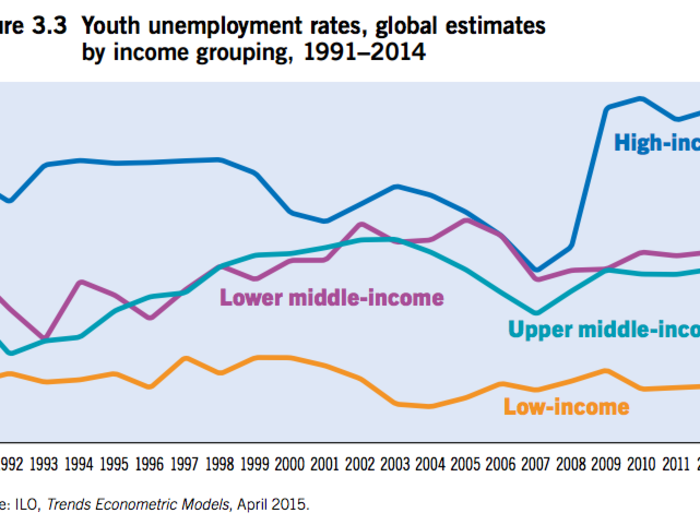
Interestingly, as absolute poverty continues to drop and more people are getting educated, young people are becoming more choosy: They don't immediately have to settle for whatever jobs they can find, but will sometimes wait around to see if they can get one of the coveted jobs — aka those that are "worth" their education.
"This is one of the reasons why youth unemployment rates, defined according to the standard 'strict' definition are higher in middle-income than low-income countries," notes the ILO.
31. Dominican Republic: 30.6%
30. Georgia: 31.5%
29. Jordan: 31.8%
28. Albania: 32.3%
27. Suriname: 32.8%
26. Slovakia: 33.8%
25. Jamaica
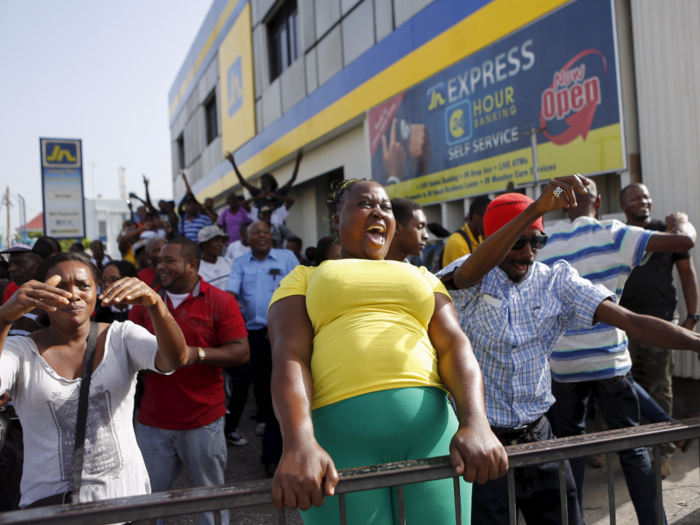
2014 youth unemployment rate (est.): 34.3%
Percentage of population aged 15-24 | under 24: 21.46% | 49.43%
Jamaica, along with Barbados, Trinidad and Tobago, and the Bahamas, saw the highest youth-unemployment rates in the Caribbean, according to a 2014 study by the World Bank.
Although there was limited data available on the Caribbean, World Bank analysts suggest that poor educational attainment and disadvantaged family backgrounds predispose many to unemployment.
"Youth unemployment ... generates discouragement, disaffection, isolation, and lack of ownership and of purpose among youth," the World Bank says. "These sentiments in turn increase the chances of youth engaging in risky activities such as [teen pregnancy], substance abuse, and crime and violence."
Source: ILO, CIA World Factbook?
24. Botswana
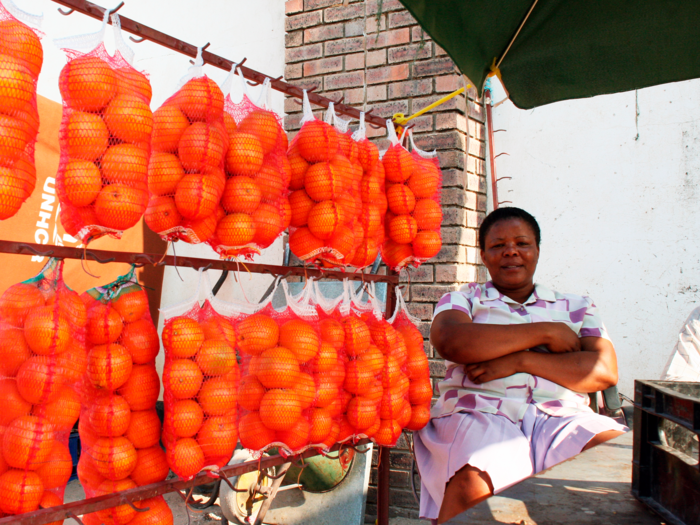
2014 youth unemployment rate (est.): 35.3%
Percentage of population aged 15-24 | under 24: 21.49% | 54.15%
Botswana is one of the most stable countries in Africa, and is now considered a middle-income nation. It is the world's largest diamond producer, and the government wants to diversify into other sectors.
But even with economic prosperity, there are extremely poor pockets within the country, and there is a significant population of illegal immigrants from Zimbabwe. Additionally, about 20% to 30% of adults in Botswana are HIV-infected, according to the World Bank.
Source: ILO, CIA World Factbook
23. Gabon

2014 youth unemployment rate (est.): 35.7%
Percentage of population aged 15-24 | under 24: 20.29% | 62.35%
Gabon is one of the bigger oil producers in Africa, which has led to huge economic growth over the last decade. Oil alone accounts for 45% of GDP, 60% of budget revenue, and 80% of exports, according to World Bank figures. Unfortunately, the oil business is not very labor-intensive, and only about 5% of the population actually works in the sector.
About one-third of Gabonese citizens still live below the poverty line even though the GDP per capita is relatively high.
Source: ILO, CIA World Factbook
22. Iraq
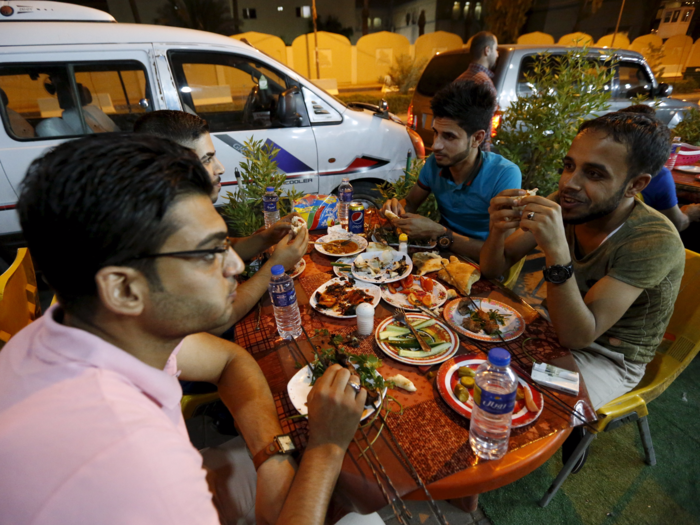
2014 youth unemployment rate (est.): 35.9%
Percentage of population aged 15-24 | under 24: 18.98% | 59.23%
Iraq's "picture continues to darken" politically and economically. The country's extremely young population has a high unemployment rate, most notably among educated youths and university grads. In fact, the higher the educational attainment, the higher the unemployment rate.
The economic activity rate (EAR, measuring how many people in a certain age group are active or potentially active in the labor market) for 15- to 29-year-olds was just 38.4%. But illiterate individuals saw the highest EAR (76%) among males, according to a 2014 UN report.
"Unemployment is one of the major causes of tension among the youth ... This feeling intensifies among poor young people ... the increasingly widespread feeling of injustice ... fuels the social and economic polarization that generates impoverishment and exclusion," the UN report noted.
Source: ILO, CIA World Factbook
21. Portugal

2014 youth unemployment rate (est.): 35.9%
Percentage of population aged 15-24 | under 24: 11.41% | 27.09%
Many Portuguese youths have left the country in search of other opportunities abroad. Additionally, some analysts have pointed out that Portugal's unemployment rate is actually worse than it seems, as statistics omit some people who are technically unemployed.
Although Portugal's rate was lower than that of others' in 2013, "the rate is notable for its longer-run trend: Youth unemployment in Spain, Greece and Italy was stable or falling in the first half of the decade, but in Portugal youth unemployment has been trending upward since 2000," according to the St. Louis Fed.
Source: ILO, CIA World Factbook
20. Namibia
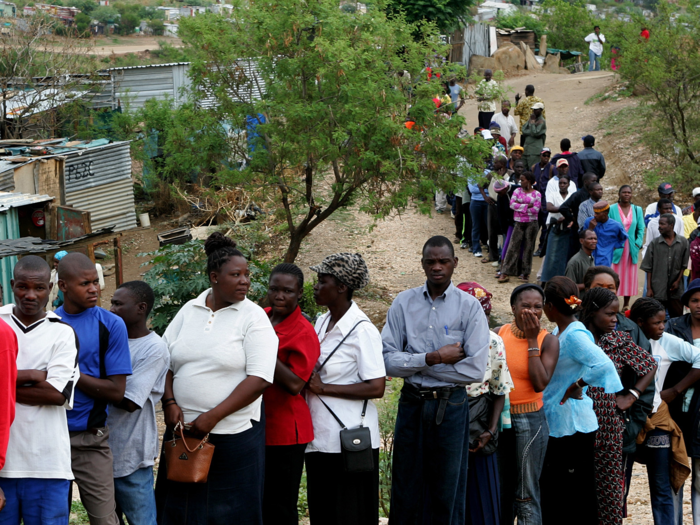
2014 youth unemployment rate (est.): 36.8%
Percentage of population aged 15-24 | under 24: 23.11% | 54.06%
Namibia is a stable country in southwest Africa that gained independence from South Africa in 1990. While it has grown economically in the last 25 years, the unemployment rate has been virtually unchanged since independence. Youth unemployment is higher in rural areas than urban areas, and unemployment is higher among females than males.
Most people tend to be "in elementary occupations (25.5%) followed by service and sales (17.6%), skilled agriculture (15.5%), and craft and trade (14.8%), according to the Namibia Statistics Agency.
Source: ILO, CIA World Factbook
Youth unemployment is particularly striking in North Africa and the Middle East, with both regions around 30%.
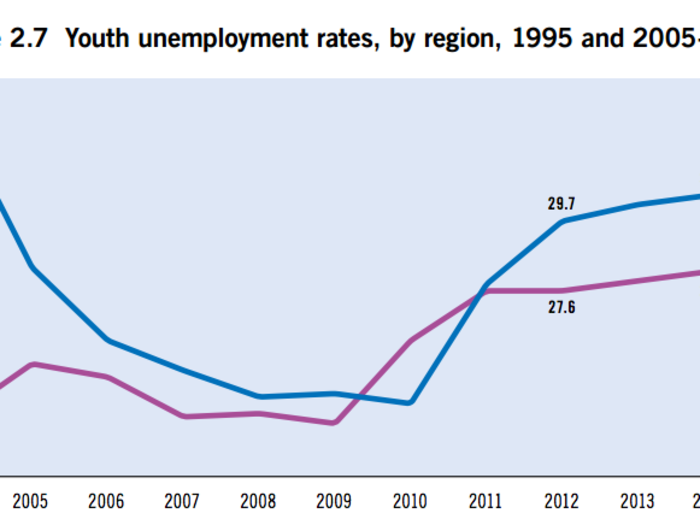
Education and other labor-assisting programs have been implemented in many North African and Middle Eastern rates, and, indeed, the youth in the region are "doing well in terms of near universal education" — even among women.
But the ILO notes that " the persistent high unemployment among both youth and adults in the regions denotes the deep-rooted structural elements that cannot be resolved by supply-side policies alone."
Moreover, the presence of extremist groups in these regions adds an additional risk, which you can read about in more detail in specific slides.
19. Cyprus: 37.1%
18. Lesotho: 37.3%
17. Italy: 38.3%
16. Egypt: 39.3%
15. Montenegro: 40.5%
14. Armenia: 40.6%
13. Tunisia

2014 youth unemployment rate (est.): 40.7%
Percentage of population aged 15-24 | under 24: 15.53% | 35.56%
Tunisia's National Dialogue Quartet navigated the country through the post-Arab Spring turmoil and laid the groundwork for democracy, and recently won the Nobel Peace Prize. But at the same time, the country's youth unemployment has only gotten worse.
Some analysts have noted that these unemployed youths are then targeted by extremist groups.
A high youth-unemployment rate “helps prepare an environment where it’s easier for that narrative to take root. It makes some of them more receptive,” J. Peter Pham, director of the Africa Center at the Atlantic Council, told IB Times. “For the person looking for a job or struggling to make ends meet, macroeconomic theory doesn’t put bread on the table.”
Source: ILO, CIA World Factbook
12. Swaziland
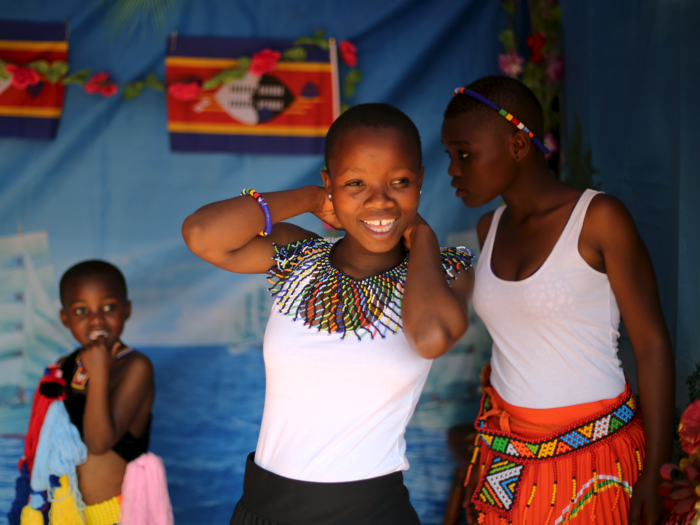
2014 youth unemployment rate (est.): 44%
Percentage of population aged 15-24 | under 24: 22.26% | 58.25%
Swaziland is one of the last absolute monarchies left, and King Mswati III has been ruling since 1986.
Many in Swaziland have lost their jobs in recent years as the garment and sugar export sectors lost trading concessions, and the labor market deteriorated significantly from 2007 to 2010.
"With these rates and trends, youth unemployment ceased to be an economic issue only. As the 2011 experiences from North Africa showed, if unaddressed, the low and declining youth employment could lead to social and political unrest," according to a 2013 paper by the AfDB.
Source: ILO, CIA World Factbook
11. Mauritania
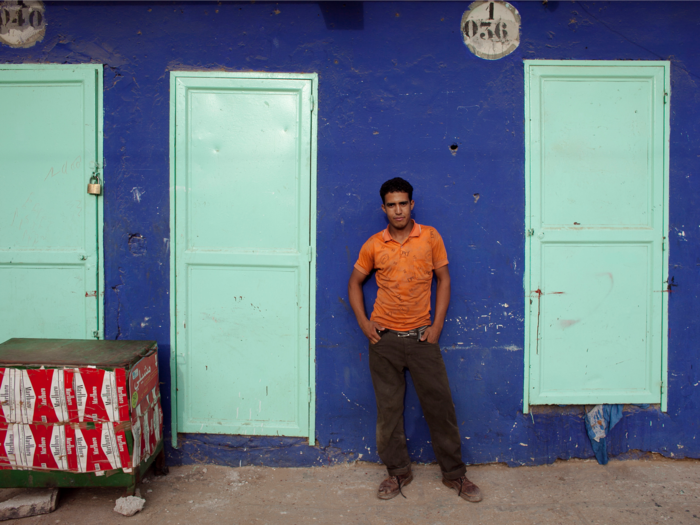
2014 youth unemployment rate (est.): 44.9%
Percentage of population aged 15-24 | under 24: 19.9% | 59.08%
Mauritania is one of the leading exporters of iron ore and also has major potential with gold and copper. Additionally, it's a "modest" oil producer and has big natural-gas deposits in the Banda region. But the poverty rate remains high, and there is a lack of human capital-intensive sectors and governance issues, and the country is highly susceptible to exogenous shocks, according to the World Bank.
Notably, even though Mauritania has a high youth-unemployment rate, the country did not experience popular uprisings like other North African nations did in 2011, as the AfDB points out.
Source: ILO, CIA World Factbook
10. Serbia

2014 youth unemployment rate (est.): 46.6%
Percentage of population aged 15-24 | under 24: 11.46% | 26.2%
Serbia is currently trying to get EU membership, and is thus looking at "painful" reforms, according to the BBC.
"The employment conditions of young workers make them particularly exposed during times of economic crisis," notes a report by the ILO. "Whereas adult workers often enjoy full-time and open-ended contracts, most Serbian youth are engaged in the informal economy, holding flexible part-time and fixed-term contracts. They are thus often the first ones to be dismissed from employment. They also sometimes return to education and their labor force participation rate is reduced."
Source: ILO, CIA World Factbook
9. Croatia

2014 youth unemployment rate (est.): 49.5%
Percentage of population aged 15-24 | under 24: 11.92% | 26.34%
Croatia was growing at 4% to 5% annually before the financial crisis, but hasn't been able to get back on its feet. "Progress in addressing inactivity and unemployment, the main cause of the recent rise in poverty, remains slow," according to the World Bank.
Most recently, after Hungary closed its boarders, thousands of refugees were redirected into the Balkans, including into Croatia. Given that the Balkans already have their own economic problems, a huge influx of refugees could add some risk.
Source: ILO, CIA World Factbook
8. South Africa
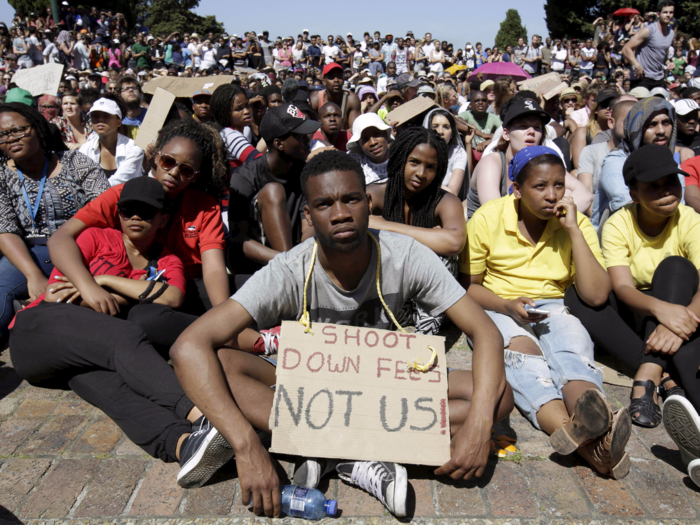
2014 youth unemployment rate (est.): 52.9%
Percentage of population aged 15-24 | under 24: 18.52% | 46.95%
Each year, only about 15% of students who begin a degree at a South African university or technical college graduate. Many dropouts can't afford to pay the tuition — especially those in the much-poorer black population. These people who leave school then do not have the required skills demanded for the labor market.
Earlier in 2015, universities wanted to increase the cost of education by 10% to 12%, which led to mass protests by South African students in October. The students were ultimately successful, as universities decided not to increase fees in 2016.
Source: ILO, CIA World Factbook
4. to 7.
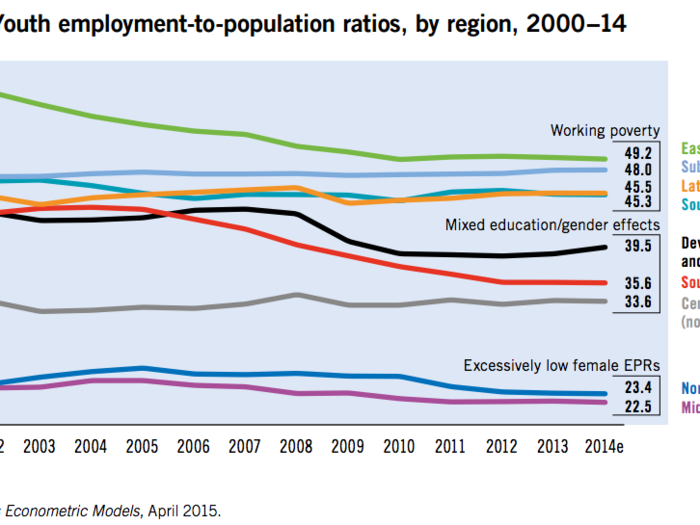
While Europe has been all over the headlines for high youth-unemployment rates over the last half-decade, Asian regions and part of sub-Saharan Africa have seen relatively low rates, according to data from the ILO.
Additionally, youth-unemployment rates have been decreasing in Central and South-Eastern Europe (non-EU) and the Commonwealth of Independent States, Latin America, the Caribbean, and sub-Saharan Africa in the medium and long terms.
7. Macedonia: 54.32%
6. Réunion: 54.41%
5. Martinique: 54.7%
4. Guadeloupe: 55.1%
3. Spain
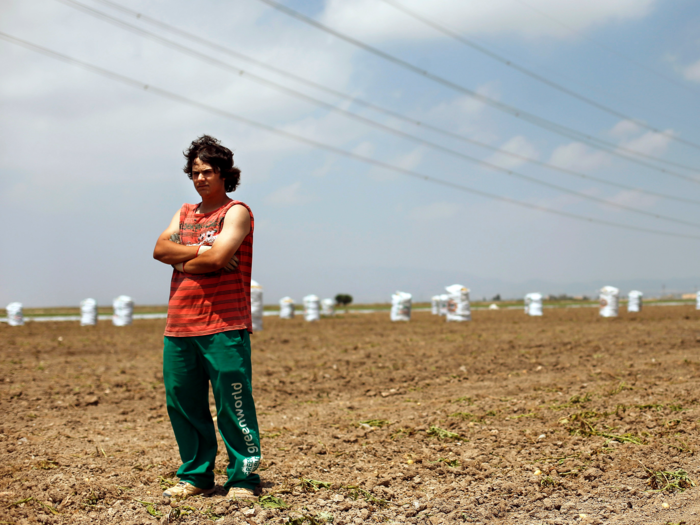
2014 youth unemployment rate (est.): 58.2%
Percentage of population aged 15-24 | under 24: 9.56% | 25.01%
Not only does Spain have an insanely high youth-unemployment rate, but it also has the highest school-dropout rate in Europe. Spain went through a decade-long construction boom when many young people dropped out of school to snag these well-paid construction gigs. But when the construction boom was over, Spain was left with a bunch of unskilled 20-somethings without jobs, according to Reuters.
Now, unskilled Spaniards are turning to jobs that immigrants have been doing, and skilled workers are settling for jobs they're overqualified for.
Source: ILO, CIA World Factbook
2. Bosnia and Herzegovina
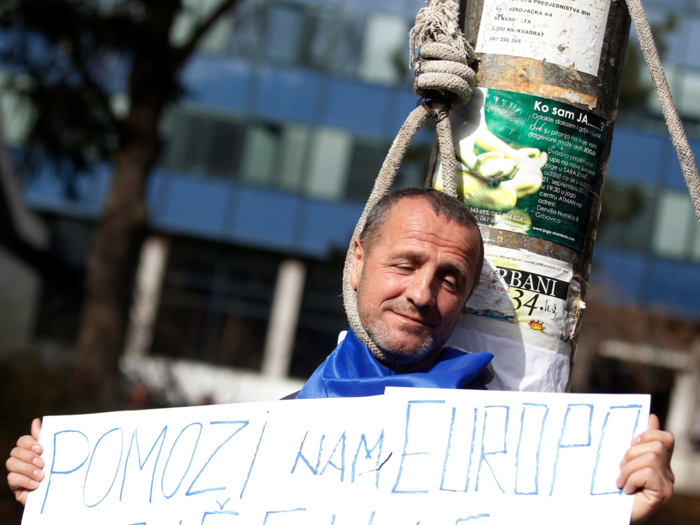
2014 youth unemployment rate (est.): 60.2%
Percentage of population aged 15-24 | under 24: 12.36% | 25.84%
Private-sector jobs in Bosnia and Herzegovina "offer very low wages and poor working conditions" and "workers are vulnerable to exploitation. With demands for employment so high, employers can constantly leverage the threat of layoffs." Plus, Bosnia has a brain-drain issue, too.
Additionally, as with other Balkan countries, the influx of migrants could add more risk.
“We have much empathy in the region for migrants but countries across the region are poor, their institutions are not yet developed, and most states can barely deal with the daily problems of government, never mind a migration crisis,” Sead Numanovic, a former editor of a leading Bosnian newspaper, told The New York Times. “These countries just don’t have the capacity.”
Source: ILO, CIA World Factbook
1. Greece
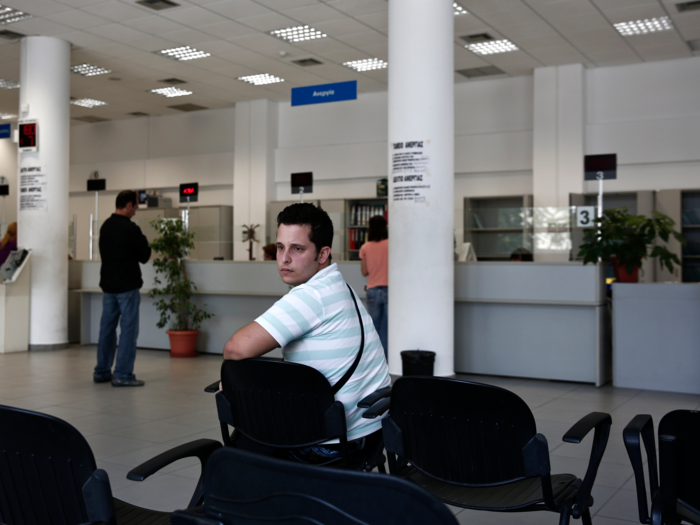
2014 youth unemployment rate (est.): 64.8%
Percentage of population aged 15-24 | under 24: 9.72% | 23.73%
Greece has been front and center in 2015 during its battle against its European creditors. But the country's economic problems have been building for a long time. Almost half the time since its independence has been spent in a financial crisis, corruption has cost the country 8% to 10% of GDP per year, and upper-middle-class professionals have dodged taxes for years.
Unfortunately, many youths have graduated into this economy. Over half of those between the 25 and 34 live at home, and many have a hard time finding jobs.
Source: ILO, CIA World Factbook
Popular Right Now
Popular Keywords
Advertisement
